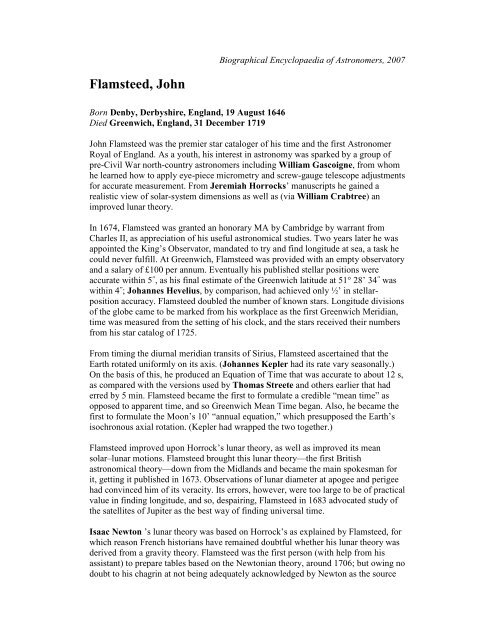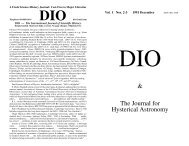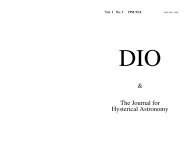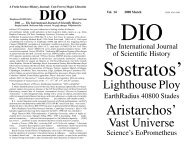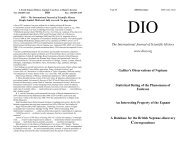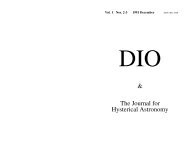Flamsteed, John - DIO, The International Journal of Scientific History
Flamsteed, John - DIO, The International Journal of Scientific History
Flamsteed, John - DIO, The International Journal of Scientific History
You also want an ePaper? Increase the reach of your titles
YUMPU automatically turns print PDFs into web optimized ePapers that Google loves.
Biographical Encyclopaedia <strong>of</strong> Astronomers, 2007<br />
<strong>Flamsteed</strong>, <strong>John</strong><br />
Born Denby, Derbyshire, England, 19 August 1646<br />
Died Greenwich, England, 31 December 1719<br />
<strong>John</strong> <strong>Flamsteed</strong> was the premier star cataloger <strong>of</strong> his time and the first Astronomer<br />
Royal <strong>of</strong> England. As a youth, his interest in astronomy was sparked by a group <strong>of</strong><br />
pre-Civil War north-country astronomers including William Gascoigne, from whom<br />
he learned how to apply eye-piece micrometry and screw-gauge telescope adjustments<br />
for accurate measurement. From Jeremiah Horrocks’ manuscripts he gained a<br />
realistic view <strong>of</strong> solar-system dimensions as well as (via William Crabtree) an<br />
improved lunar theory.<br />
In 1674, <strong>Flamsteed</strong> was granted an honorary MA by Cambridge by warrant from<br />
Charles II, as appreciation <strong>of</strong> his useful astronomical studies. Two years later he was<br />
appointed the King’s Observator, mandated to try and find longitude at sea, a task he<br />
could never fulfill. At Greenwich, <strong>Flamsteed</strong> was provided with an empty observatory<br />
and a salary <strong>of</strong> £100 per annum. Eventually his published stellar positions were<br />
accurate within 5˝, as his final estimate <strong>of</strong> the Greenwich latitude at 51° 28’ 34˝ was<br />
within 4˝; Johannes Hevelius, by comparison, had achieved only ½’ in stellarposition<br />
accuracy. <strong>Flamsteed</strong> doubled the number <strong>of</strong> known stars. Longitude divisions<br />
<strong>of</strong> the globe came to be marked from his workplace as the first Greenwich Meridian,<br />
time was measured from the setting <strong>of</strong> his clock, and the stars received their numbers<br />
from his star catalog <strong>of</strong> 1725.<br />
From timing the diurnal meridian transits <strong>of</strong> Sirius, <strong>Flamsteed</strong> ascertained that the<br />
Earth rotated uniformly on its axis. (Johannes Kepler had its rate vary seasonally.)<br />
On the basis <strong>of</strong> this, he produced an Equation <strong>of</strong> Time that was accurate to about 12 s,<br />
as compared with the versions used by Thomas Streete and others earlier that had<br />
erred by 5 min. <strong>Flamsteed</strong> became the first to formulate a credible “mean time” as<br />
opposed to apparent time, and so Greenwich Mean Time began. Also, he became the<br />
first to formulate the Moon’s 10’ “annual equation,” which presupposed the Earth’s<br />
isochronous axial rotation. (Kepler had wrapped the two together.)<br />
<strong>Flamsteed</strong> improved upon Horrock’s lunar theory, as well as improved its mean<br />
solar–lunar motions. <strong>Flamsteed</strong> brought this lunar theory—the first British<br />
astronomical theory—down from the Midlands and became the main spokesman for<br />
it, getting it published in 1673. Observations <strong>of</strong> lunar diameter at apogee and perigee<br />
had convinced him <strong>of</strong> its veracity. Its errors, however, were too large to be <strong>of</strong> practical<br />
value in finding longitude, and so, despairing, <strong>Flamsteed</strong> in 1683 advocated study <strong>of</strong><br />
the satellites <strong>of</strong> Jupiter as the best way <strong>of</strong> finding universal time.<br />
Isaac Newton ’s lunar theory was based on Horrock’s as explained by <strong>Flamsteed</strong>, for<br />
which reason French historians have remained doubtful whether his lunar theory was<br />
derived from a gravity theory. <strong>Flamsteed</strong> was the first person (with help from his<br />
assistant) to prepare tables based on the Newtonian theory, around 1706; but owing no<br />
doubt to his chagrin at not being adequately acknowledged by Newton as the source
<strong>of</strong> both the lunar data and the Horroxian theory, he never acknowledged how effective<br />
the theory was. Posthumously, his lunar theory, the tabular procedure for finding<br />
lunar longitude based on the Newtonian text—which was the basis <strong>of</strong> his<br />
employment—was found to have disappeared from Greenwich and so was absent<br />
from the three volumes <strong>of</strong> the Historia Coelestis Britannica , but made a surprising<br />
reappearance in the hands <strong>of</strong> Pierre le Monnier in the 1740s who published it. (It was<br />
presumably donated by Edmond Halley, <strong>Flamsteed</strong>’s erstwhile friend, and, finally,<br />
successor.)<br />
In 1681, <strong>Flamsteed</strong> published his “Doctrine <strong>of</strong> the Sphere” containing tables <strong>of</strong> the<br />
Equation <strong>of</strong> Center for the lunar and solar ( i. e ., <strong>of</strong> the Earth) elliptical motions,<br />
derived from an exact solution <strong>of</strong> the Kepler Equation, within 1˝ or so. <strong>The</strong>reby he<br />
became the first astronomer to apply Kepler’s first and second laws <strong>of</strong> planetary<br />
motion. This was before Newton had started to take seriously Kepler’s second law,<br />
and when various ad hoc procedures were current for constructing these tables.<br />
In his Gresham lecture <strong>of</strong> May 1681, <strong>Flamsteed</strong> gave the first-ever British account <strong>of</strong><br />
the perihelion passage <strong>of</strong> a comet behind the Sun, that <strong>of</strong> comet C/1680 V1. Newton<br />
decided to reject the latter’s view in favor <strong>of</strong> two separate comets. Owing to its close<br />
solar passage, this comet became the first for which a mathematical orbit could be<br />
reliably computed, thanks to <strong>Flamsteed</strong>’s exact measurements.<br />
<strong>Flamsteed</strong> decided to measure right ascension using sidereal time, which later became<br />
the “Greenwich Hour Angle,” a method described in Edmond Halley's preface to his<br />
'pirate' Historia <strong>of</strong> 1712 as 'a somewhat daring hypothesis.' His star-classification<br />
procedure became the basis <strong>of</strong> the “<strong>Flamsteed</strong> numbers” used in the British Catalogue<br />
for numbering the stars. He became (unknowingly) the first astronomer to log the<br />
passage <strong>of</strong> Uranus.<br />
With no ancient star-maps to consult, <strong>Flamsteed</strong> brushed up his Greek to read the<br />
original Ptolemy, and concluded (from arguments about right and left shoulders) that<br />
all the human constellation figures had to be turned round and that we perceive the<br />
globe <strong>of</strong> the Universe from the inside. His star-maps became the most widely used in<br />
Europe in the 18th century. He developed a novel stereographic projection for the<br />
maps (the Samson–<strong>Flamsteed</strong> method).<br />
<strong>Flamsteed</strong> can hardly be blamed for confounding stellar aberration <strong>of</strong> the Pole Star<br />
(which he discovered), <strong>of</strong> some 20˝ magnitude each year, with the long-sought stellar<br />
parallax (due to the Earth’s orbit). He published his conclusion in 1697. What<br />
<strong>Flamsteed</strong> found was (as Giovanni Cassini pointed out) 90° out <strong>of</strong> phase from<br />
where the parallax should have been. In contrast, his ascertaining <strong>of</strong> solar parallax<br />
(half the angle subtended by Earth from the Sun) <strong>of</strong> 10˝, the correct value being 9˝,<br />
was <strong>of</strong> pr<strong>of</strong>ound importance. Horrocks had estimated it as 15˝, while Tycho Brahe<br />
retained the ancient value <strong>of</strong> 3’. Solar distance relied upon this value. In <strong>Flamsteed</strong>’s<br />
words, “<strong>The</strong> Sun is and ever was above ten times more remote than commonly<br />
esteemed.”<br />
<strong>Flamsteed</strong> assured Newton that Jupiter’s satellites were exactly adhering to Kepler’s<br />
third law, as appeared at the opening <strong>of</strong> the Principia ’s Book III without<br />
acknowledgement. He collaborated with Newton to construct seasonally varying
atmospheric refraction tables <strong>of</strong> much-improved accuracy. He composed a history <strong>of</strong><br />
astronomy (in the Preface to his Historia ) in which he rejected trepidation, whereby<br />
the equinoctial points oscillated back and forth against the zodiac, which<br />
contemporaries such as Robert Hooke and Cassini still accepted, and established the<br />
value <strong>of</strong> precession at 1° per 72 years.<br />
From 1689, when <strong>Flamsteed</strong> acquired his precision mural arc, he was able to obtain<br />
the high-accuracy lunar-transit measurements, wherein Newton discerned the<br />
feasibility <strong>of</strong> an improvement in the theory. Tradition holds that <strong>Flamsteed</strong> refused to<br />
cooperate but in the first half <strong>of</strong> 1695 when Newton became immersed in the subject<br />
<strong>Flamsteed</strong> kindly supplied him with over 150 high-precision readings (now lost).<br />
Newton was unable to derive the lunar irregularities from his gravity theory.<br />
<strong>Flamsteed</strong> became his scapegoat for this and was forbidden to report that he had spent<br />
the best part <strong>of</strong> a year obtaining and processing these data.<br />
<strong>Flamsteed</strong>’s hope for publishing his work, as the century turned, rested on his visually<br />
attractive star-maps, which would appeal to the monarch, but the committee set up by<br />
Newton to oversee its publication, or possibly stall it, had other ideas. In 1712,<br />
Edmond Halley published <strong>Flamsteed</strong>’s stolen observations on the justification that<br />
Newton needed the lunar data. Francis Baily argued against this view on the grounds<br />
that Newton had long since finished his lunar work and that there were no grounds to<br />
suppose <strong>Flamsteed</strong> had not cooperated. Baily admired <strong>Flamsteed</strong>’s “piety, integrity,<br />
and independent spirit.” Meeting him in 1683 when <strong>Flamsteed</strong> was thirty-seven years<br />
<strong>of</strong> age, the Irishman William Molyneaux described him as 'A free, affable and<br />
Humble man, not at all conceited or dogmatical.'<br />
Nicholas Kollerstrom<br />
Selected References<br />
Baily, Francis (1835). An Account <strong>of</strong> the Revd. <strong>John</strong> <strong>Flamsteed</strong> . (Reprint, London:<br />
Dawson, 1966.)<br />
Birks, <strong>John</strong> (1999). <strong>John</strong> <strong>Flamsteed</strong> . London: Avon.<br />
Chapman, Allan (ed.) (1982). <strong>The</strong> Preface to <strong>John</strong> <strong>Flamsteed</strong>’s Historia Coelestis .<br />
London: Britannica.<br />
Forbes, Eric G. (1975). Greenwich Observatory . Vol. 1, Origins and Early <strong>History</strong><br />
(1675–1835) . London: Taylor and Francis.<br />
Forbes, Eric G., Murdin Lesley, and Francis Willmoth (eds.) (1995–2001). <strong>The</strong><br />
Correspondence <strong>of</strong> <strong>John</strong> <strong>Flamsteed</strong>, the First Astronomer<br />
Royal . 3 vols. Bristol: Institute <strong>of</strong> Physics.<br />
Kollerstrom, Nicholas (2000). Newton’s Forgotten Lunar <strong>The</strong>ory: His Contribution to<br />
the Quest for Longitude . Santa Fe: Green Lion.<br />
Kollerstrom, Nicholas and Bernard, D. Yallop (1995). “<strong>Flamsteed</strong>’s Lunar Data,<br />
1692–95, Sent to Newton.” <strong>Journal</strong> for the <strong>History</strong> <strong>of</strong><br />
Astronomy 26: 237–246.<br />
Whiteside, D. T. (1976). “Newton’s Lunar <strong>The</strong>ory: From High Hope to<br />
Disenchantment.” Vistas in Astronomy 19: 317–328.<br />
Willmoth, Frances (ed.) (1997). <strong>Flamsteed</strong>’s Stars: New Perspectives on the Life and<br />
Work <strong>of</strong> the First Astronomer Royal, 1646–1719.


